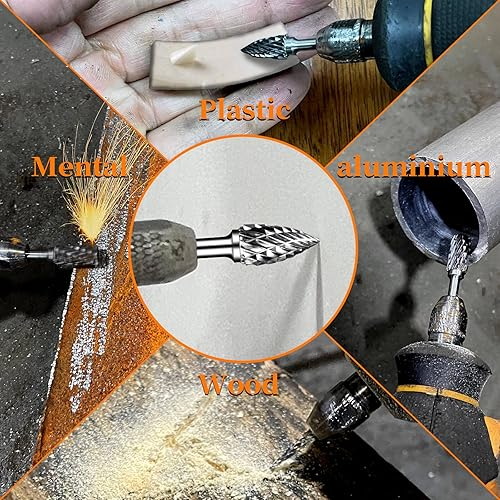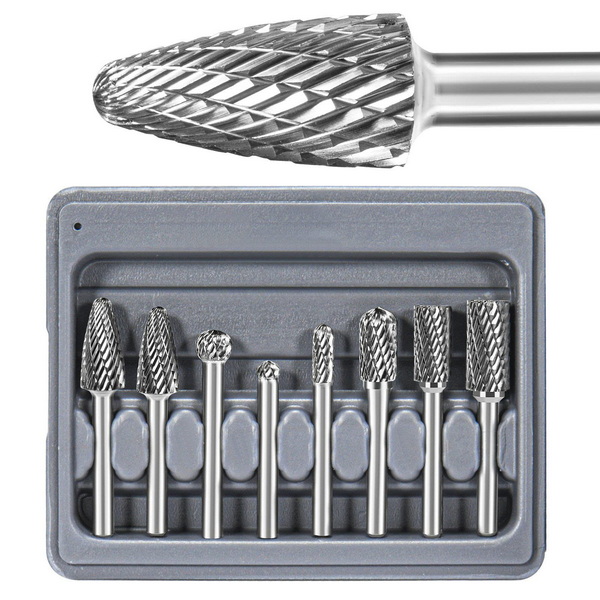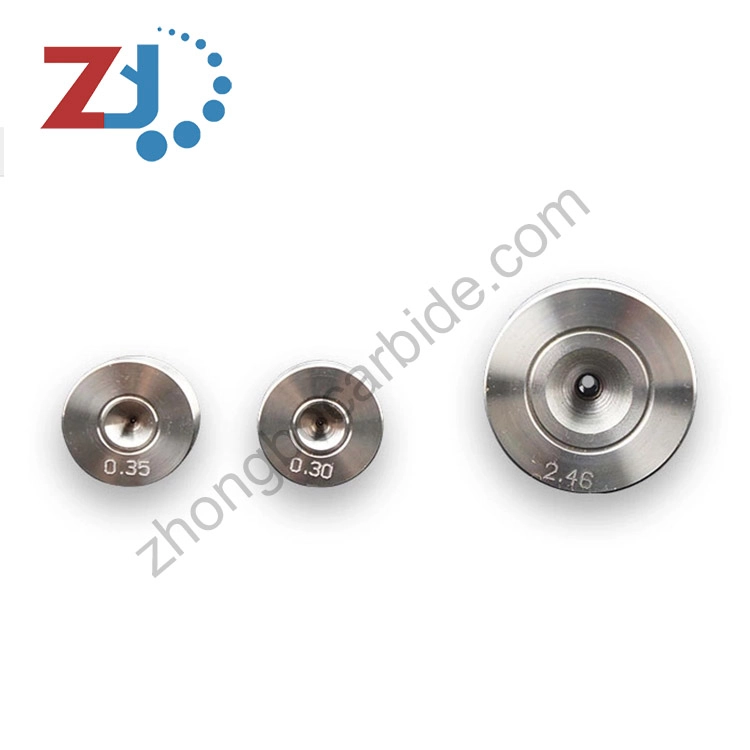Content Menu
● The Power of Tungsten Carbide
>> Key Properties of Tungsten Carbide:
● Tungsten Carbide Die Grinders and Steel
>> Why Tungsten Carbide Die Grinders Excel on Steel:
● Applications of Tungsten Carbide Die Grinders on Steel
>> 1. Deburring and Edge Finishing
>> 2. Weld Preparation and Cleaning
>> 3. Surface Grinding and Shaping
>> 4. Hole Enlargement and Modification
>> 5. Mold and Die Making
● Types of Tungsten Carbide Burrs for Steel
>> 1. Ball Shape
>> 2. Cylinder Shape
>> 3. Tree Shape
>> 4. Flame Shape
>> 5. Cone Shape
● Best Practices for Using Tungsten Carbide Die Grinders on Steel
>> 1. Choose the Right Burr
>> 2. Maintain Proper Speed
>> 3. Apply Consistent Pressure
>> 4. Ensure Proper Lubrication
>> 5. Wear Protective Equipment
● Advantages of Tungsten Carbide Die Grinders for Steel
● Limitations and Considerations
● Comparison with Other Steel-Working Tools
● Conclusion
● FAQ
>> 1. Can tungsten carbide die grinders be used on hardened steel?
>> 2. How long do tungsten carbide burrs typically last when used on steel?
>> 3. Are there any special safety precautions to take when using carbide die grinders on steel?
>> 4. Can tungsten carbide die grinders be used for precision work on steel?
>> 5. How do tungsten carbide die grinders compare to diamond-coated tools for steel work?
● Citations:
Tungsten carbide die grinders are powerful and versatile tools that have revolutionized the metalworking industry. When it comes to working with steel, these tools have proven to be exceptionally effective, offering precision, durability, and efficiency that surpass many other cutting and grinding tools. In this comprehensive guide, we'll explore the capabilities of tungsten carbide die grinders when used on steel, their benefits, applications, and best practices for optimal performance.

The Power of Tungsten Carbide
Tungsten carbide is a compound of tungsten and carbon that possesses remarkable properties, making it ideal for cutting and grinding tools. Its exceptional hardness, wear resistance, and ability to maintain sharpness even under high temperatures make it particularly suitable for working with tough materials like steel[1].
Key Properties of Tungsten Carbide:
1. Hardness: Tungsten carbide has a hardness rating significantly higher than steel, allowing it to cut and grind steel effectively.
2. Wear Resistance: The material's resistance to wear ensures that carbide burrs maintain their cutting edge for extended periods.
3. Heat Resistance: Tungsten carbide can withstand high temperatures without losing its structural integrity or hardness.
4. Strength: The compound's strength allows it to endure the stresses of cutting and grinding steel without breaking or chipping[1].
Tungsten Carbide Die Grinders and Steel
Tungsten carbide die grinders, equipped with carbide burrs, are indeed highly effective when working on steel. These tools can handle various types of steel, including hardened steel, with remarkable efficiency[1].
Why Tungsten Carbide Die Grinders Excel on Steel:
1. Superior Cutting Ability: The hardness of tungsten carbide allows it to cut through steel with ease, maintaining a sharp edge throughout the process.
2. Precision: Carbide burrs offer excellent control, allowing for precise shaping and grinding of steel surfaces.
3. Durability: The wear resistance of tungsten carbide ensures that the tools last longer, even when working on tough steel materials.
4. Versatility: Carbide burrs come in various shapes and sizes, making them suitable for a wide range of steel-working applications[2].
Applications of Tungsten Carbide Die Grinders on Steel
Tungsten carbide die grinders find extensive use in various industries for working on steel. Here are some common applications:
1. Deburring and Edge Finishing
Carbide burrs are excellent for removing burrs and sharp edges from steel components, ensuring smooth and safe surfaces[2].
2. Weld Preparation and Cleaning
These tools are ideal for preparing steel surfaces for welding and cleaning up weld seams after the process[2].
3. Surface Grinding and Shaping
Tungsten carbide die grinders can efficiently grind and shape steel surfaces, creating desired contours and finishes[1].
4. Hole Enlargement and Modification
Carbide burrs are effective for enlarging or modifying existing holes in steel components[2].
5. Mold and Die Making
In the tooling industry, tungsten carbide die grinders are crucial for creating and refining steel molds and dies[1].
Types of Tungsten Carbide Burrs for Steel
Different shapes of carbide burrs are designed for specific tasks when working with steel. Here are some common types:
1. Ball Shape
Ideal for grinding, countering, hole-deburring, carving, and shaping steel surfaces[2].
2. Cylinder Shape
Perfect for side cutting, creating flat bottoms, and working on larger steel surfaces[2].
3. Tree Shape
Excellent for rapid stock removal and rough shaping of steel components[2].
4. Flame Shape
Suitable for creating detailed carvings and grooves in steel[2].
5. Cone Shape
Ideal for creating countersinks, counterbores, and narrow contours in steel[2].

Best Practices for Using Tungsten Carbide Die Grinders on Steel
To maximize the effectiveness and longevity of tungsten carbide die grinders when working on steel, consider the following best practices:
1. Choose the Right Burr
Select the appropriate burr shape and size for your specific steel-working task[2].
2. Maintain Proper Speed
Operate the die grinder at the recommended speed for the specific carbide burr and steel type you're working with[5].
3. Apply Consistent Pressure
Use steady, moderate pressure to avoid overheating and premature wear of the carbide burr[1].
4. Ensure Proper Lubrication
When necessary, use appropriate cutting fluids or lubricants to reduce friction and heat generation[5].
5. Wear Protective Equipment
Always use proper safety gear, including eye protection, gloves, and respiratory protection when working with steel and carbide burrs[5].
Advantages of Tungsten Carbide Die Grinders for Steel
Using tungsten carbide die grinders for steel offers several advantages:
1. Efficiency: Carbide burrs can remove material from steel surfaces quickly and effectively.
2. Precision: The tools allow for accurate and detailed work on steel components.
3. Versatility: Various burr shapes enable a wide range of steel-working applications.
4. Durability: Tungsten carbide's wear resistance ensures long-lasting performance.
5. Cost-Effectiveness: Despite higher initial costs, the longevity of carbide burrs makes them economical in the long run[1].
Limitations and Considerations
While tungsten carbide die grinders are highly effective on steel, there are some limitations to consider:
1. Initial Cost: Carbide burrs are generally more expensive than other grinding tools.
2. Brittleness: Tungsten carbide can chip if subjected to sudden impacts or dropped.
3. Skill Requirement: Proper technique is crucial to avoid damaging the workpiece or the tool.
4. Heat Generation: High-speed grinding can generate significant heat, requiring proper cooling techniques[1].
Comparison with Other Steel-Working Tools
To understand the effectiveness of tungsten carbide die grinders on steel, let's compare them with other common steel-working tools:
| Tool | Hardness | Wear Resistance | Heat Resistance | Precision | Cost |
| Tungsten Carbide Burrs | High | Excellent | Excellent | High | High |
| High-Speed Steel (HSS) Tools | Moderate | Good | Moderate | Moderate | Moderate |
| Diamond-Coated Tools | Very High | Excellent | Good | Very High | Very High |
| Ceramic Abrasives | High | Good | Excellent | Moderate | Moderate |
This comparison highlights the balanced performance of tungsten carbide die grinders, offering a combination of hardness, wear resistance, and precision that makes them particularly suitable for working on steel[1].
Conclusion
Tungsten carbide die grinders are indeed highly effective tools for working on steel. Their exceptional hardness, wear resistance, and heat tolerance make them ideal for various steel-working applications, from deburring and surface grinding to precision shaping and mold making. While they may have a higher initial cost, their durability and versatility often make them a cost-effective choice in the long run.
For professionals and DIY enthusiasts alike, mastering the use of tungsten carbide die grinders can significantly enhance the quality and efficiency of steel-working projects. By choosing the right burr, following best practices, and understanding the tool's capabilities and limitations, users can achieve outstanding results when working with steel.
As metalworking technology continues to advance, tungsten carbide die grinders are likely to remain a crucial tool in the industry, offering the precision and durability needed for demanding steel-working tasks.

FAQ
1. Can tungsten carbide die grinders be used on hardened steel?
Yes, tungsten carbide die grinders can effectively work on hardened steel. The exceptional hardness of tungsten carbide allows it to maintain its cutting edge even when grinding or shaping hardened steel surfaces. However, it's important to use the appropriate burr shape and follow recommended speed and pressure guidelines for optimal results and tool longevity[1].
2. How long do tungsten carbide burrs typically last when used on steel?
The lifespan of tungsten carbide burrs when used on steel can vary depending on factors such as usage frequency, applied pressure, and the specific type of steel being worked on. Generally, high-quality tungsten carbide burrs can last significantly longer than other types of grinding tools, often providing hundreds of hours of use before needing replacement. Proper use and maintenance can further extend their lifespan[1].
3. Are there any special safety precautions to take when using carbide die grinders on steel?
When using carbide die grinders on steel, it's crucial to follow standard safety practices:
- Always wear appropriate personal protective equipment, including safety glasses, gloves, and a dust mask.
- Ensure proper ventilation in the work area to manage metal dust.
- Secure the workpiece properly to prevent movement during grinding.
- Be aware of the potential for sparks and heat generation, especially when working on hardened steel.
- Follow the manufacturer's recommendations for speed settings and handling of the tool[5].
4. Can tungsten carbide die grinders be used for precision work on steel?
Absolutely. Tungsten carbide die grinders are excellent for precision work on steel. The various shapes and sizes of carbide burrs allow for detailed and accurate material removal. Ball-shaped and flame-shaped burrs, for instance, are particularly useful for intricate work. The tool's ability to maintain a sharp edge ensures consistent precision throughout the task[2].
5. How do tungsten carbide die grinders compare to diamond-coated tools for steel work?
While both tungsten carbide and diamond-coated tools are effective for working on steel, they have different characteristics:
- Tungsten carbide is more cost-effective and offers a good balance of hardness and toughness.
- Diamond-coated tools are harder but more brittle and expensive.
- Tungsten carbide performs better at higher temperatures, making it more suitable for high-speed grinding of steel.
- Diamond-coated tools may offer slightly better precision for extremely fine work.
For most steel-working applications, tungsten carbide die grinders provide an excellent combination of performance, durability, and value[1].
Citations:
[1] https://www.soobill.com/news/ultimate-guide-carbide-burrs-for-steel/
[2] https://www.empireabrasives.com/blog/the-different-types-of-tungsten-carbide-burrs-and-their-applications/
[3] https://rightlines.co.uk/collections/tungsten-carbide-burrs
[4] https://www.ebay.co.uk/itm/192460589639
[5] https://ingcostores.com/products/hrrc0051-ingco-5pcs-set-tungsten-carbide-rotary-burrs-set-for-die-grinder
[6] https://www.shutterstock.com/search/carbide-burr
[7] https://www.aliexpress.com/item/1005005850871869.html
[8] https://www.indiamart.com/proddetail/rotary-burr-bit-set-tungsten-carbide-point-die-grinder-shank-carving-tools-2851840121630.html
















